|
|
Dear Wisconsin beekeepers and those interested in honey bees and wild pollinators:
This is the third quarterly update of 2023 from the Wisconsin Department of Agriculture, Trade and Consumer Protection’s (DATCP) apiary program. Please let us know how you use this newsletter and send any feedback, questions, or ideas for future updates to Frances.Hegarty@wisconsin.gov.
|
|
|
Whether you are an armchair enthusiast who loves all things bee-related or are on the global front lines of honey bee research, the hit podcast show Two Bees in a Podcast is the place to learn, delight, and inspire in discussions about our favorite little insects. Hosted by members of the University of Florida's Honey Bee Research and Extension Laboratory, Dr. Jamie Ellis and Ms. Amy Vu have produced over 130 episodes of these free weekly installments. Most episodes feature a guest speaker, management tips from Dr. Ellis, and a riveting Q&A segment answering listeners’ burning apiculture questions. Sessions include topics such as honey bee management, pests, disease, nutrition, queen issues, pesticides, and turning honey products into business profit. Researcher guests provide cutting edge findings about ways to combat the global threats to honey bee populations with titles such as “Effect of Microplastics on Honey Bees,” “Nutrition and Viral Resilience,” and “Supporting Bees in Urban Spaces."
The show’s lively hosts strive to showcase diverse and timely topics, from basic beekeeping practices to highly specialized scientific research. If a beekeeping podcast sounds like something you might enjoy, tune in by visiting our lab’s website at https://entnemdept.ufl.edu/honey-bee/podcast/, or find it wherever you source your podcasts (Anchor.fm and distributed on Apple Podcasts, Spotify, Anchor, Podbean, Google Podcasts, Facebook, and Twitter.)
Article Credit: UF/IFAS Honey Bee Research and Extension Laboratory staff.
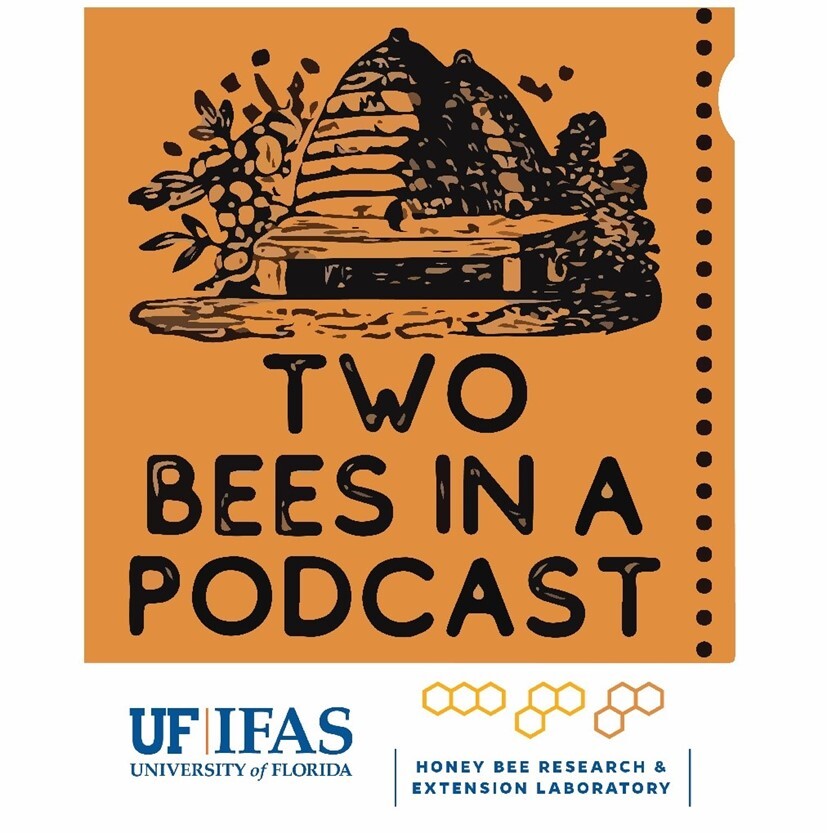 Logo: Two Bees in a Podcast. University of Florida (UF), Institute of Food and Agricultural Sciences (IFAS), Honey Bee Research & Extension Laboratory.
|
|
|
For information about honey bee pest treatment options labeled for use in Wisconsin, see the Wisconsin Honey Bee Pest Management Options document. It has been updated for 2023 and is a guide of short summaries of lawful treatment options for various honey bee pests and diseases. Side one focuses on Varroa mites and side two includes information on other pests and diseases. This list is updated annually and serves as an additional resource for Wisconsin beekeepers. It also contains information and links to current honey bee health Best Management Practices (BMPs) and educational resources for Integrated Pest Management (IPM) for honey bee pests.
Even though this document is updated each year, labels for pesticides or prescriptions could change at any time. You must read each product label thoroughly before applying any treatments and follow label instructions precisely. See DATCP's Pests & Disease Management of Honey Bees webpage for more information.
Photo: Honey bees (and queen) on comb
|
|
|
Check out this new, educational webinar from the EPA about protecting honey bees and Integrated Pest Management (IPM) for Varroa mites. It focuses on creating an individualized IPM plan tailored to your honey bee colony's needs. The presenters are experts in their field and discuss Varroa mite sampling techniques, monitoring timelines, and proper treatment options. Wisconsin beekeepers should use this video along with the Wisconsin Honey Bee Pest Management Options document and product label(s).
Varroa mites are a ubiquitous honey bee pest which feed on honey bees and spreads viruses. If left unchecked and unmanaged, these mites can lead to colony loss.
|
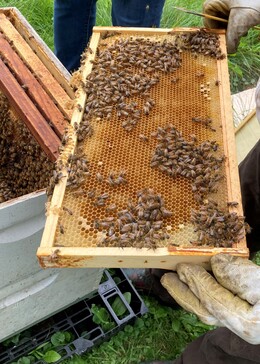 Photo: Looking at honey bees on a frame
|
|
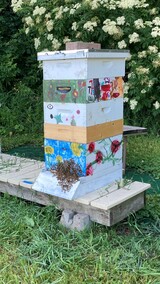 Photo: Honey bee colony in the garden
|
|
Another new resource is this great introductory video about managing hive pests from the North Carolina Department of Agriculture & Consumer Services. It includes information about multiple hive pests, the appropriate use of pesticides, and product labels. If you are a Wisconsin beekeeper, use this video along with the Wisconsin Honey Bee Pest Management Options document and product label(s).
|
|
|
Whether you’re a beekeeper with hives near crop fields, an organic farmer, or you grow other types of specialty crops, you can benefit from signing up to inform pesticide applicators of your presence – especially aerial spray applicators who may be applying treatments near you. Pesticide applicators can also use this registry as a part of their communication process with beekeepers and various types of growers.
Beecheck™, Driftwatch™, and Fieldwatch™ are free, online registries that allow beekeepers and growers to communicate with pesticide applicators about their locations to help prevent accidental exposure to pesticides. Fieldwatch is also the name of the nonprofit organization that operates all three registries.
- Beecheck™ is a registry for hive owners. Registrants list specific sites when they sign up, which are mapped so that applicators can view them. Applicators can use this information as part of their stewardship activities. Register for Beecheck™
- Driftwatch™ is a registry for growers of organic crops, grapes, fresh market fruits and vegetables, and other sensitive crops grown on a half-acre or more. Register for Driftwatch™
- Fieldwatch™ is a registry for applicators who want to receive this information. Register for Fieldwatch™
There are benefits to letting aerial applicators know about your hive locations. They may take additional steps beyond their normal procedures, such as creating a wider buffer or changing their application method if they know that a bee yard is near their work site. It can also lead to better communication and the development of relationships to reduce the likelihood of misunderstandings and accidental exposures. Although a password is required to log on and enter information onto the Beecheck™, Driftwatch™, and Fieldwatch™ websites, the map of registered properties is available to the public. Here is a map of all registered properties in Wisconsin.
Separate from a Beecheck™ registration, Wisconsin law (ATCP 29.53) requires applicators to notify adjacent residents that provide them with a written request in the same calendar year at least 24 hours in advance of any aerial pesticide application. Additionally, applicators are also required to notify beekeepers who make a written request at least 24 hours before a pesticide labeled “Highly Toxic to Bees" or containing the active ingredient methomyl is applied to any site that is 1.5 miles or closer to their colonies (ATCP 29.51). The notice may be written or oral and must include the date and time of application, brand or common name of the pesticide, and the location of the application site. Finally, Wisconsin law (ATCP 29.50) also states that, “No person may use or direct the use of a pesticide in a manner that results in pesticide overspray or significant pesticide drift.” Although some pesticides may “volatilize,” or evaporate after application, causing the pesticide to drift, even if applied properly, cases of suspected pesticide misuse impacting your bees should be reported immediately to 608-224-4500 or email datcppesticideinfo@wi.gov.
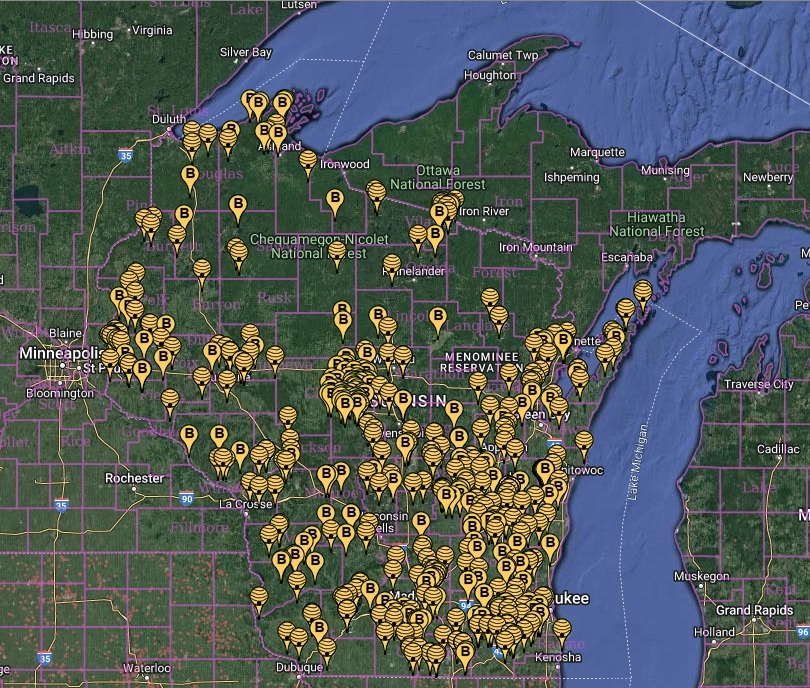 Map: Driftwatch™ map of voluntary beehive listings (registered via Beecheck™) in Wisconsin, Summer 2023.
|
|
|
Pollinator Week 2023 was celebrated in June, but many wonderful Wisconsin Pollinator Week resources are available online throughout the year. For example, the Wisconsin Public Radio Garden Talk Episode titled Planting for Pollinators, from June 10, 2023, is available for listeners. Additionally, the UW-Extension Pollinator Week webpage also has many educational resources and webinars.
|
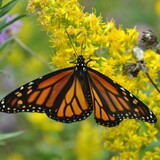 Photo: Monarch butterfly on goldenrod
|
|
|
|
|